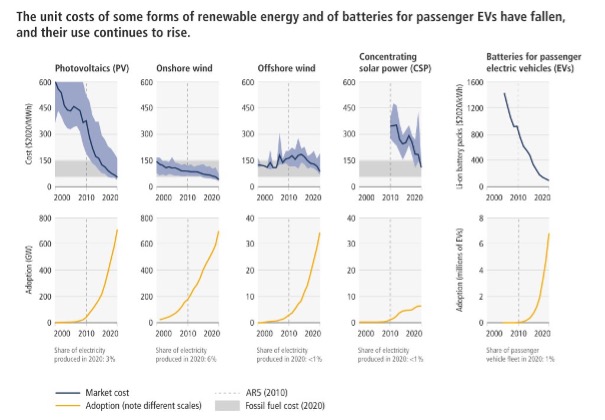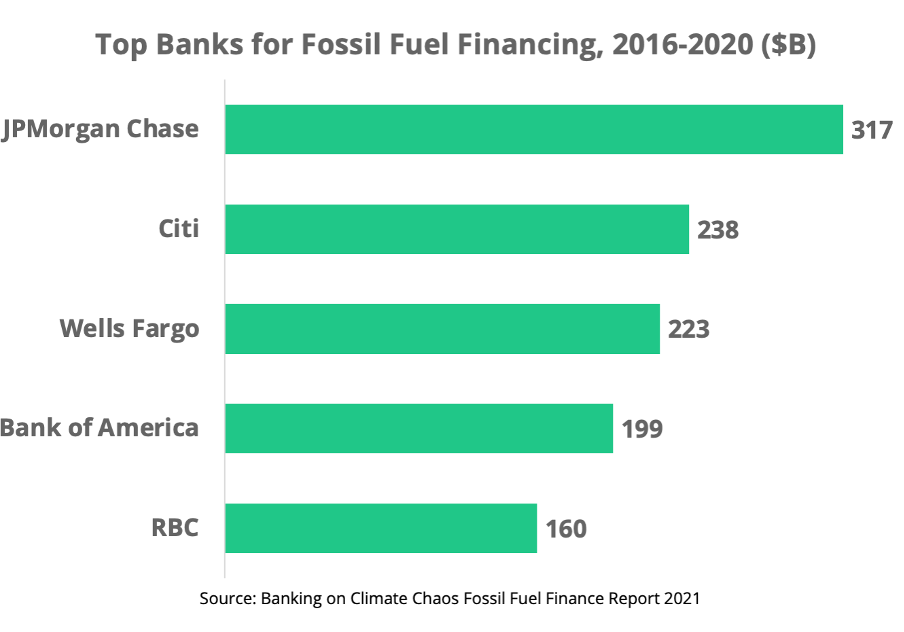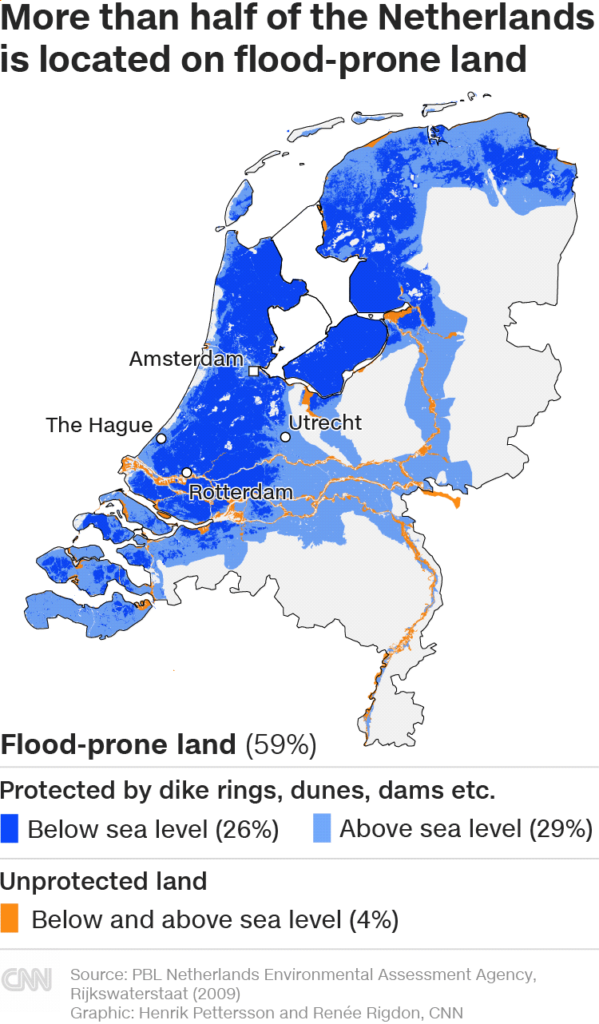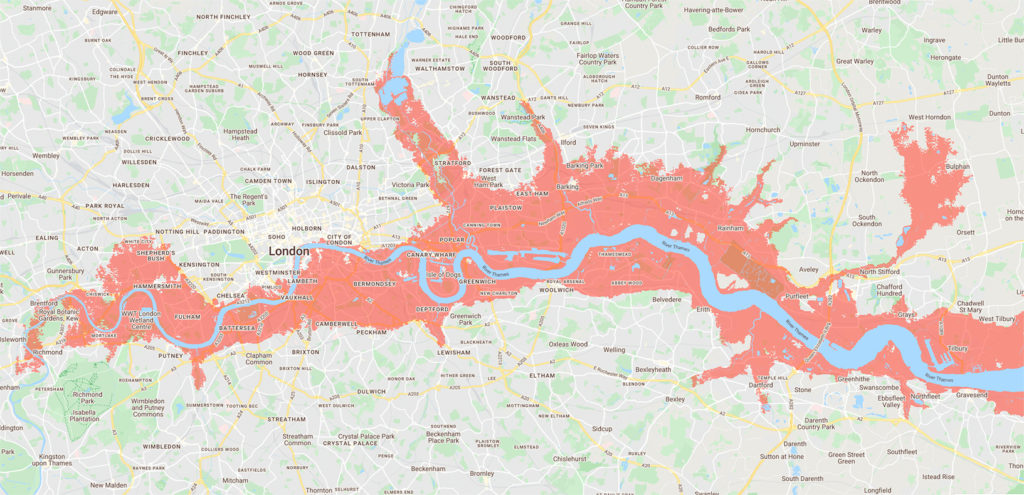FRIDAY 8 April
The IPCC on climate mitigation: How can we save humanity from itself?

Giacomo Zattini, Climate Justice Activist at Fridays for Future
Yesterday we saw the release of the third part of the sixth IPCC climate report. Why is it so important?
In December the first part was released, which tells us about the damage to the planet. A month ago the second part came out, which talks about the damage we are doing to ourselves. This last part talks about mitigation, about the solutions to the climate crisis.
Good climate news: yes, there are solutions.
We know how to produce clean, low-cost energy. The technologies are there, what is needed is political will and investment.

Cost of the main renewable energy sources and increase in their use over the last 20 years. Source: 6th IPCC report, 2022.
But there is one thing we do not have: time to waste. In his opening speech, UN Secretary-General Antonio Guterres made it clear: “Some governments and business leaders say one thing and do another. Simply put, they are lying. And the result will be catastrophic, this is a climate emergency”.
The IPCC report on climate mitigation: “It’s now or never”
The peak of climate-changing emissions must be reached by 2025. After that, it will have to fall dramatically. By 2030 we should have reduced net emissions by 43%, and this is possible if we make a serious effort. That’s eight years. There is no one solution for every context, but every context (energy, cities, transport, food) has its solutions. “Now or never” says the IPCC. There are no more excuses. Today the obstacles are only political and financial. We have to unblock finance and the IPCC says it clearly, the money is there, but it is being diverted elsewhere. Where? Here:

This graph shows the thousands of billions that financed coal, oil and gas from 2016 to 2020
It is clear that every time we hear the phrase “it can’t be done”, they are actually telling us that they don’t want to do it. Immediately after the release of the IPCC report, many people on social media also noted that “science is cautious” and that this report “has been watered down by nations in negotiations”, said Greta Thunberg in a tweet. One more motivation to act.
We don’t need fear, but the courage to act
Guterres: “Climate activists are sometimes depicted as dangerous radicals, but the truly dangerous radicals are the countries that are increasing the production of fossil fuels. Investing in fossil fuels infrastructure is moral and economic madness.”
This report shows us what we could do, if we wanted to. It confronts all of us, politicians and citizens, with a crossroads in history. There will be no other major IPCC reports in the next few years, we will have to make do with this one to find the courage we need to change.
WEDNESDAY 23 March
Understanding the latest IPCC report: How will the climate crisis affect you?

Helena Wieländner, Climate Justice Activist at Fridays for Future
The Intergovernmental Panel on Climate Change (IPCC) has published their latest report on climate change. With everything going on in the world right now, many people missed it. But the facts in the report are chilling and cannot be ignored. It’s time to face them together.
The report looks at the ways humans and nature are vulnerable to the climate crisis – and what we need to do to protect ourselves. It provides evidence for what climate activists are already fighting for: there is a rapidly narrowing window of opportunity to reduce global warming down to 1.5°C.
The IPCC report is written very technically. It’s more for scientists and policymakers than for “normal people”. But it affects all of us – yes, even in the European Union. It’s about our survival. About whether our planet will remain habitable for us and for the plants and animals we share it with. It’s so important that we understand what’s coming. How can we manage the climate crisis? What can we do to stop it?
Continue reading to find out what the IPCC report says about how the climate crisis will affect us – and what we can do about it.
What is the IPCC climate report and what does it say?
Every 7 years, the IPCC publishes an assessment report on climate change. There have been six full reports since it was established in 1988. The reports are split into four parts from different Working Groups (WG). Now, in February 2022, the WG2 presented their part of the 6th assessment report. The latest IPCC report concentrates on the impacts of climate change and how we can adapt to the climate crisis. It also looks at human vulnerability. It forces us to think about how climate change is affecting people’s lives right now, instead of “only” talking about future changes to nature, biodiversity and the weather. Maybe this finally makes it possible for us all to grasp how urgent this topic is and that there’s no time to waste anymore.
Generally speaking, the report repeats what we already knew: we’re going to face immense sea level rise leading not only to unknown islands drowning but also cities, like London, or even whole countries, like the Netherlands, vanishing beneath the sea. Heatwaves will hit the most vulnerable people more frequently. Food security and water availability will decrease. Biodiversity loss and extreme weather events won’t be rare anymore. Up to 3.6 billion people will be extra vulnerable due to their age, where they live, poverty and so on. Yes, billion, you read that right. It’s almost every second person on the planet.
Okay, now we know what to expect. We also know that the Western world is responsible for most CO2 emissions, even though they won’t feel the harshest consequences. But, as we said, climate change affects everyone. Yes, there will be other countries that are much more vulnerable to the immediate impact of the climate crisis. But in Europe, we must work on our resilience against recurring natural disasters too.
Just to pick one example, the projected sea level rise would put cities next to rivers (like London) and Low Elevation Coastal zones (like in the Netherlands) at an extreme risk of regular flooding… and eventually sinking. Here you can see the shocking sea level rise map of London projected for 2030. It shows that large parts of the UK’s capital will be underwater in only eight years’ time (click on the image below to open the interactive in a new window):

It is not a secret that – being mostly built on water – more than half of the land of the Netherlands is already at flood risk. It is unimaginable what the country would look like after a drastic sea level rise. This map of the Netherlands shows which parts of the country are already on flood-prone land:
As the climate crisis worsens, let’s also not forget that we’ll face problems with our food and water supplies due to droughts and extreme weather events. The IPCC FAQs state that:
“Children aged ten or younger in the year 2020 are projected to experience a nearly four-fold increase in extreme events under 1.5°C of global warming by 2100, and a five-fold increase under 3°C warming. Such increases in exposure would not be experienced by a person aged 55 in the year 2020 in their remaining lifetime under any warming scenario”.
All these catastrophes will cost trillions of dollars each year. And, most importantly of all, an uncountable number of human lives.
Yeah, we know. This sounds terrible. But we aren’t powerless – on the contrary! The IPCC says we still have time to prevent the worst scenarios. We can still adapt to climate change and grow resilience towards natural disasters.
“The only condition is that we act now!”
First and foremost, let’s be really clear: it’s not everyday people who are responsible for climate disasters. We all do what we can, but changing our own behaviour doesn’t make sense without supporting policies and harsh restrictions on big companies. More than 70% of CO2 emissions come from just 100 companies. No prizes for guessing that most of them are oil suppliers.
That doesn’t mean that we shouldn’t do our best to consume consciously. But it’s the politicians who must act now! They hold the power to turn the tide. A first step would be to carry out changes that will help us adapt to climate change and lessen its effects, known as climate adaptation and climate mitigation. Climate adaptation has its limits. Just for visualisation: when we’re hot, we can only take off so many clothes before we’re naked. So there needs to be an even stronger focus on slowing down climate change.
We need to hold global warming under 1.5°C. To achieve this we need strong climate laws for the EU and for our home countries. We need restrictions on companies that emit too much CO2. We need subsidies for companies to become more sustainable. The solutions are actually already there. What we really need are politicians willing to make these solutions into laws.
But what to do if my politicians don’t act, you ask? Well, most of them won’t take urgent action on their own. They’ll need people putting pressure on them. They need to see that enough people care deeply about the climate. We need them to know that we won’t be tricked by greenwashing in politics (like when the European Commission recently suggested adding gas and nuclear power to their list of “sustainable investments”). They need to feel that they have to address the climate crisis to stay in power.
One strategy in politics is to overcomplicate things so people won’t understand enough to complain. But they don’t know our generation – we won’t stop fighting for our right to a socially just and liveable world.
So, let’s be clear here: every fraction of a degree that we keep below the 1.5°C limit matters. Every degree saves lives, and every saved life is worth the fight. So, it’s always worth fighting. We have a duty to stop a catastrophe. But we also have an opportunity to do things differently. To change our world and improve our quality of life. Not only for us, but for everyone who shares this planet.
If you want to support the protest, channel your energy, be loud and show your frustration, join the Global Climate Strike organised by Fridays For Future.
The next one takes place on Friday 25th March 2022. Find out where the nearest Climate Strike is to you.
See you there!
The IPCC Report – Glossary
Climate Mitigation
Mitigation aims at limiting global warming so the harm is not going to be too bad. It’s the sword in our fight against the climate crisis.
Climate Adaptation
To adapt to climate change means trying to reduce the expected harm and taking advantage of beneficial opportunities. It’s like building the right armour for the fight.
Climate Resilience
Resilience is needed to withstand the expected climate catastrophes. Like a shield that protects us.
Vulnerability to the Climate Crisis
Vulnerable people are especially exposed to climate change impacts, like heat, drought and floods. One cannot simply break this down by gender or age. It’s about an intersectional approach which takes diverse aspects into consideration. Vulnerable people might face challenges to hold a sword, a shield or wear armour which is why we need to protect them even more.
